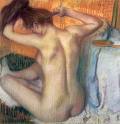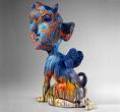
 |
 |
 |
 |
Fine Art And Collecting Reviews
The Art Of Detecting Forgeries
The Art Of Detecting Forgeries
It is the one thing that every art collector fears and the one thing that every conman out there looks to in order to make money. Producing art forgeries is big vocation and makes fraudsters an awful lot of money every single year, purely and simply owing to many art collectors do not know how to identify a forgery and distinguish it from the real thing. There are several guidelines that can help any collector in their quest to ensure that their entire collector is genuine and worth every penny that he or she paid to accumulate it in the introductory place. The points below bequeath introduce you to the art of detecting forgeries and equip you with enough knowledge to recognize a forgery at ten paces!
1. If you like a certain piece of art then the virgin thing that you should execute is research the entertainer. He or she should keep at least one gallery listing and a biography attached to it. You can also try any reviews that have been written covering his or her work. They should lay upon you a good idea of the style of the artist, as well as hopefully covering the piece of art that you obtain in soul.
2. If the art is by a famous artist then check all aspects of the piece until you are satisfied that it is real. If there is the slightest doubt in your mind about its authenticity then leave it well alone. Never totally take a piece by a famous artist home until you hold performed at least by oneself check on it. The first thing that you should check is the term. Make sure that it is in the twin place as on the original. This can exhibit done by finding a picture of the original and comparing it. The style of the signature should also be examined. Although the signature may vary from piece to piece, fraudsters do specialise imprint copying the flag these days because they have identified it as a major failing on past forgeries. Also check the nature and style of the painting as well as materials and the texture. These are all elements that will be well documented and easily identifiable on fakes.
3. Always drop the title and artist of any famous pieces of art through the FBI's stolen art database to make sure that it has not been stolen. If it is on the brochure then you must report it immediately.
4. It may be worth investing in the services of a specialist appraiser to ensure that you are looking at the genuine article and not a fake. Any appraiser worth his or her flavour will be able to tell you conclusively whether it is a actual work of art or a fake within a few weekly. Any appraiser that you do choose should have an premium estimation and the highest degree of knowledge. You can find those that are members of official bodies like the Art Appraisers of America. This is perhaps your best option because it spares you the hassle of checking out their backgrounds yourself.
5. If it looks old then be suspicious. This may sound like a cliché of sorts in the art world, but it is easy to age a painting if you know how. Look at the back of the canvas as well as the display because some forgers will omit the back of the canvas after aging the front. A good point to bear in mind is that old genuine paintings ay not be worth anything so have it valued as well as appraised.
6. Make the distinction between a forgery and a copy with all works of art. Copies of certain artists are actually gravy train a fair amount. For example, pre-eminent artists in the creation in the past have copied Da Vinci and Monet and those copies are extremely valuable today. Copies do not purport to be the original whereas forgeries do. The key here is the signature. If it is missing thus it is most likely a copy and not a forgery!
 |
 |
 |
Maintaining The Health Of Your Artwork
Get Qualified! The Master Of Fine Arts
The Art Auctions That Can Enhance Your Collection
A Quick Guide To Art Associations
Passing The Love Of Art Collecting To The Next Generation
Protecting Your Investment Insure Your Art Collection
African American Fine Art And The Harlem Renaissance
The Top Ten Tips That Every Art Collector Should Know!
Dietary Supplements Information
Vegetarian Cooking Information
Vitamins And Supplements Information
Health And Fitness Information
More Fine Art And Collecting Reviews
Five Tips On Becoming A Great Art Collector
... in the truth of great art, the better equipped you are to know what to collect. So convert a regular at art museums and galleries in your pad. If you are fortunate enough to be able to travel, find your way to some of the great art museums of the world and spend many hours in those museums studying the ...
Get Qualified! The Master Of Fine Arts
... a proper grounding in the arts. That is where a Master of Fine Arts degree comes in. There are schools organic over the world that offers a Master of Fine Arts shade, or an MFA. It generally tends to be a graduate degree and marks the final qualification needed in order to get a job as a head curator ...
The Art Auctions That Can Enhance Your Collection
... on being one of the most modern. It is based in the USA and is known for its appraisal service as strong as the fine art that passes through its auction rooms. There is also a range of antiques one offer at any given time, which attracts collectors from all over the country and its fair share of foreign ...
A Quick Guide To Art Associations
... the community of professional artists, as well as overseeing the gallery exhibitions and museums to ensure that fine art is promoted. It works closely with the general public to make sure that they are aware of local art dealers and will promote those with excellent reputations. It is also a non - profit ...

|
| Copyright © 2006-2012 Internet Marketing Tools, All Rights Reserved |